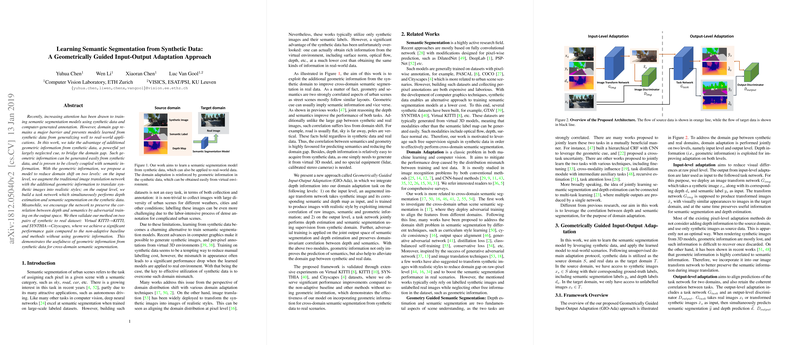Learning Semantic Segmentation from Synthetic Data: A Geometrically Guided Input-Output Adaptation Approach
In the paper, "Learning Semantic Segmentation from Synthetic Data: A Geometrically Guided Input-Output Adaptation Approach," the authors present a novel approach aimed at leveraging synthetic data to improve semantic segmentation performance when applied to real-world scenarios. The research addresses the prominent issue of domain gap, which often hinders models trained solely on synthetic data from performing effectively in realistic environments.
Approach and Methodology
The paper introduces the Geometrically Guided Input-Output Adaptation (GIO-Ada) framework. The authors implement domain adaptation on two distinct levels to mitigate domain shift, harnessing the untapped potential of geometric information available in synthetic datasets. The two levels are:
- Input-Level Adaptation: The input-level adaptation utilizes an image transform network augmented with additional geometric information (such as depth) from synthetic data to bridge the visual discrepancies between synthetic and real images. This network is tasked with producing transformed images that resemble real-world images while preserving semantic and geometric cues. An adversarial loss is employed to ensure that the transformed images are indistinguishable from real images by a discriminator.
- Output-Level Adaptation: In the output-level adaptation, a task network is designed to concurrently perform depth estimation and semantic segmentation on the synthetic input. This dual-task network benefits from adversarial training that assists in maintaining domain-invariant correlations between the predicted depth and semantic outputs. Such correlations are deemed essential since geometric structure and semantics in urban scenes are intimately linked.
The integration of geometric depth information into these adaptation processes, both at the input and output levels, marks a significant shift from conventional methods that often overlook such data. The adopted adversarial learning frameworks drive the model to align synthetic data representations closely with real-world domain characteristics, thus enhancing cross-domain applicability.
Results and Evaluation
The methodology is empirically validated across two primary synthetic-to-real datasets: Virtual KITTI to KITTI and SYNTHIA to Cityscapes. The results showcase a substantial improvement in the mean Intersection over Union (mIoU) metric over baseline models that do not utilize geometric data. Specifically, the input-level adaptation yields significant gains, yet the joint input and output-level strategy exemplifies further enhancement in segmentation performance.
The experimental findings underscore the proposition that geometric information, such as depth, not only assists in refining synthetic realism during the transformation process but also fortifies the learning of inherently semantic-geometric associations that are robust to domain variations.
Implications and Future Directions
This research delineates its significance by demonstrating that synthesized geometric cues could markedly enhance domain adaptation frameworks for semantic segmentation. Such advancements could play a pivotal role in critical applications like autonomous driving, where labeled real-world data acquisition is costly and labor-intensive.
The implications also suggest several avenues for future research, including extending similar geometric-information-based adaptation techniques to other computer vision tasks or real-time adaptive systems. Additionally, exploring more complex geometric cues beyond depth, such as surface normals or optical flow, might yield further performance advancements.
In summary, the paper not only introduces a compelling adaptation approach by strategically integrating geometric information but also inspires further exploration into the vast potential of synthetic data in diverse real-world deployments.
